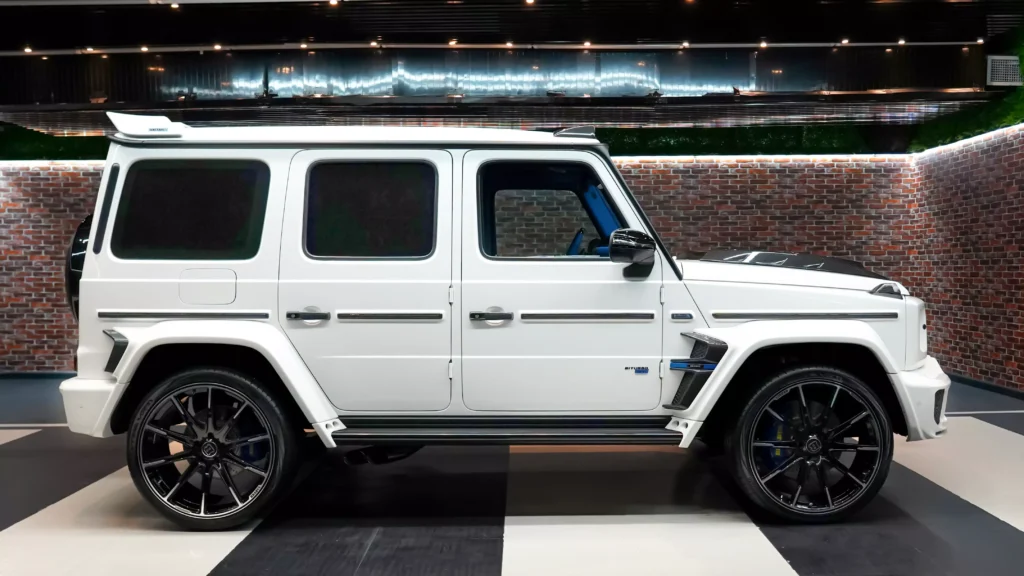The G Wagon Interior Evolution: From Military Roots to Modern Opulence begins with its utilitarian origins. Initially designed as a rugged military vehicle, the G Wagon’s cabin prioritized functionality over comfort. Early models featured spartan layouts, with minimalistic seating, basic instrumentation, and durable materials like vinyl and rubber to withstand harsh conditions. The focus was on durability, ensuring the G Wagon could endure off-road challenges and combat environments. Unlike luxury vehicles of the era, the luxurious G Wagon Interior lacked plush upholstery or advanced technology, instead emphasizing ease of maintenance and resilience. This military-inspired design philosophy laid the groundwork for its later transformation. Over time, as civilian demand grew, Mercedes-Benz recognized the potential to refine the G Wagon’s interior without compromising its iconic ruggedness. This shift marked the first step in the G Wagon Interior’s journey from utilitarian necessity to sophisticated elegance.
Luxury Takes the Wheel: The 1980s Transformation
The G Wagon Interior Evolution: From Military Roots to Modern Opulence accelerated in the 1980s, when Mercedes-Benz began blending ruggedness with refinement. As the vehicle transitioned from military to civilian use, its interior design embraced luxury elements. Plush leather upholstery, wood trim accents, and soundproofing materials replaced the stark, functional layouts of earlier models. Climate control systems and advanced sound systems were introduced, catering to affluent buyers seeking both capability and comfort. Despite these upgrades, the G Wagon retained its boxy silhouette and robust build, ensuring its off-road prowess remained intact. This era marked a pivotal shift, as the G Wagon Interior evolved from a tool for survival into a statement of sophistication. The addition of ergonomic seating and improved driver controls further enhanced usability, appealing to urban professionals and adventurers alike. By merging luxury with durability, Mercedes-Benz redefined the G Wagon as a versatile icon, setting the stage for future innovations in its interior design. Dourado Luxury Car is a dealership or a private seller specializing in used exotic cars for sale in UAE.
Technological Integration: The 1990s and Beyond
The G Wagon Interior Evolution: From Military Roots to Modern Opulence entered a new phase in the 1990s, driven by technological advancements. As automotive electronics became more sophisticated, the G Wagon’s cabin began incorporating features like digital instrument clusters, electrically adjustable seats, and advanced audio systems. These updates elevated the G Wagon Interior from a purely functional space to a connected, user-friendly environment. Safety also improved, with airbags and electronic stability control systems becoming standard. While maintaining its boxy exterior, the G Wagon’s interior adopted sleeker designs, integrating softer touchpoints and premium materials. This period saw the rise of customization options, allowing owners to personalize their cabins with bespoke stitching, exotic wood, and metallic accents. By embracing innovation without sacrificing its identity, the G Wagon solidified its reputation as a versatile luxury SUV. The 1990s laid the foundation for the modern G Wagon Interior, balancing cutting-edge tech with timeless ruggedness.
Personalization and Craftsmanship: The 2000s Refinement
The hybrid G Wagon Interior Evolution: From Military Roots to Modern Opulence reached new heights in the 2000s, emphasizing bespoke craftsmanship. Mercedes-Benz offered an expanded array of materials, including Nappa leather, open-pore wood, and hand-finished metals, transforming the G Wagon Interior into a sanctuary of luxury. Customers could select from countless color combinations, stitching patterns, and trim finishes, ensuring each vehicle reflected its owner’s taste. Heated and ventilated seats, ambient lighting systems, and premium Burmester sound systems became popular additions. Despite these opulent touches, the G Wagon retained its core DNA, with intuitive controls and a commanding driving position. This era also saw the integration of dual-screen infotainment setups, merging digital convenience with classic design cues. By prioritizing personalization, Mercedes-Benz turned the G Wagon Interior into a symbol of exclusivity. The 2000s marked a turning point, proving that a vehicle rooted in military utility could coexist with unparalleled elegance and individuality.
Modern Tech Meets Timeless Design: The 2010s Innovation
The G Wagon Interior Evolution: From Military Roots to Modern Opulence surged forward in the 2010s, embracing cutting-edge technology. The G Wagon Interior now featured MBUX (Mercedes-Benz User Experience), a responsive infotainment system with voice activation and touchscreen controls. Digital instrument panels replaced analog gauges, offering customizable displays for navigation, performance metrics, and driver assistance features. Seamless smartphone integration via Apple CarPlay and Android Auto became standard, ensuring connectivity remained effortless. Despite these advancements, the G Wagon retained its signature toggle switches and robust door handles, paying homage to its heritage. The cabin’s acoustics were meticulously engineered to minimize noise, creating a serene environment even at high speeds. This balance of innovation and tradition allowed the G Wagon Interior to appeal to both tech-savvy buyers and purists. By harmonizing modernity with its iconic design language, the G Wagon solidified its status as a timeless yet forward-thinking luxury SUV.
Sustainability and Sophistication: The Eco-Conscious Shift
The G Wagon Interior Evolution: From Military Roots to Modern Opulence took an eco-conscious turn in recent years, aligning with global sustainability trends. Mercedes-Benz introduced eco-friendly materials like DINAMICA microfiber, a recycled fabric used for seat inserts and headliners, reducing the G Wagon Interior’s environmental footprint. Sustainable wood sources and low-emission adhesives further underscored this commitment. Despite these green initiatives, luxury remained paramount, with vegan leather options and responsibly sourced metals adding refinement without compromising ethics. Advanced air filtration systems and energy-efficient climate control enhanced cabin comfort while optimizing efficiency. This shift demonstrated that opulence could coexist with environmental responsibility. The G Wagon Interior’s evolution now addressed not only aesthetics and performance but also the values of conscious consumers. By integrating sustainable practices without sacrificing quality, Mercedes-Benz ensured the G Wagon remained relevant in an era where luxury and eco-awareness go hand in hand.

